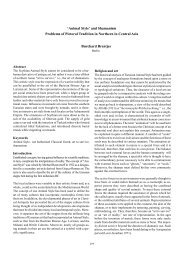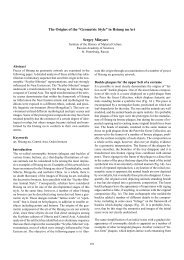Part II Archaeological Excavations - Center for the Study of Eurasian ...
Part II Archaeological Excavations - Center for the Study of Eurasian ...
Part II Archaeological Excavations - Center for the Study of Eurasian ...
You also want an ePaper? Increase the reach of your titles
YUMPU automatically turns print PDFs into web optimized ePapers that Google loves.
Kurgans, Ritual Sites, and Settlements: <strong>Eurasian</strong> Bronze and Iron Age<br />
ues reveal when and by whom <strong>the</strong> Ustyurt sanctuaries were<br />
created. Large numbers <strong>of</strong> daggers, swords, torques, and bracelets<br />
identical to those carved on <strong>the</strong> Ustyurt statues, have been<br />
excavated in Sarmatian burials dating to <strong>the</strong> 4 th –2 nd centuries<br />
BC. An iron dagger, as well a mirror, and bronze arrowheads,<br />
typical <strong>of</strong> those belonging to <strong>the</strong> Sarmatian Culture, were recovered<br />
from burials at <strong>the</strong> Baite <strong>II</strong>I and Teren sanctuaries. It is<br />
apparent, <strong>the</strong>re<strong>for</strong>e, that <strong>the</strong> Ustyurt real objects and <strong>the</strong>ir representations<br />
on <strong>the</strong> sculptures, have direct parallels with artifacts<br />
from a huge number <strong>of</strong> <strong>Eurasian</strong> steppe sites dating between<br />
<strong>the</strong> 4 th –2 nd centuries BC. The <strong>Eurasian</strong> sites, predominantly<br />
comprised funerary complexes, and have been identified<br />
both to <strong>the</strong> north <strong>of</strong> <strong>the</strong> Ustyurt Plateau in <strong>the</strong> Black Sea<br />
maritime region, <strong>the</strong> Volga and Ural regions, and nor<strong>the</strong>rn<br />
Kazakhstan as well as to <strong>the</strong> south in Khorezm and Sogdiana.<br />
Without doubt, weapons, harnesses, and household goods<br />
spread quickly and widely throughout <strong>the</strong> Great Steppe Belt<br />
and were used by ethnically unrelated groups. Consequently, it<br />
is not possible in this case to regard <strong>the</strong> majority <strong>of</strong> artifacts<br />
including weapons, jewelry, tools, and ceramic vessels as reliable<br />
ethnic indicators.<br />
Many common religious and mythological concepts resulted<br />
in <strong>the</strong> use <strong>of</strong> essentially similar funeral rites by <strong>the</strong> ancient Iranian-speaking<br />
nomads <strong>of</strong> Eurasia, including <strong>the</strong> Sarmatians and<br />
Saka-Massagetae, each divided into a number <strong>of</strong> tribal groups.<br />
It is within <strong>the</strong> context <strong>of</strong> funerary rituals, however, that it is<br />
possible to identify <strong>the</strong> unique traits <strong>of</strong> each specific ethnic<br />
group. The anthropomorphic statues and rectangular sacrificial<br />
altars, <strong>the</strong> most typical elements at <strong>the</strong> Ustyurt sanctuaries,<br />
do not have analogies within <strong>the</strong> adjacent nomadic cultures.<br />
Similarity in planigraphy, and <strong>the</strong> use <strong>of</strong> monumental statues<br />
installed in rows very close to supra-tombs (kurgans) are known<br />
from sanctuaries in sou<strong>the</strong>astern Anatolia –<strong>the</strong> hyerotesyions –<br />
dating from <strong>the</strong> 1 st century BC (at Nimrud-Dag, Kara-Kush,<br />
etc.). It is necessary to note that although <strong>the</strong> Hellenic Culture<br />
and its monumental art, so vividly embodied in <strong>the</strong> Anatolia<br />
complexes, undoubtedly made an impact on <strong>the</strong> Ustyurt artisans<br />
(Schlumberger 1970), this does not resolve <strong>the</strong> issues <strong>of</strong><br />
ethnos in <strong>the</strong> desert locale.<br />
Ano<strong>the</strong>r archaeological indication identified at <strong>the</strong> Baite <strong>II</strong>I<br />
sanctuary is <strong>the</strong> so-called Sarmatian tamgas 2 that are apparent<br />
on a number <strong>of</strong> anthropomorphic statues (Fig. 8). These are<br />
identical to a large group <strong>of</strong> tamgas widely spread throughout<br />
<strong>the</strong> western <strong>Eurasian</strong> steppes during <strong>the</strong> 1 st century BC to <strong>the</strong><br />
4 th century AD (Drachuk 1975; Vainberg and Novgorodova<br />
1976). Essentially all scholars relate <strong>the</strong> tamgas to <strong>the</strong><br />
Sarmatians (Solomonik 1959). The location <strong>of</strong> <strong>the</strong> tamgas on<br />
<strong>the</strong> anthropomorphic statues, however, suggests that <strong>the</strong>y were<br />
added to <strong>the</strong> sculptures at a later date. This assertion is also<br />
supported by <strong>the</strong> fact that <strong>the</strong> time period assigned to <strong>the</strong> sculpting,<br />
as suggested by <strong>the</strong> dagger style, does not coincide with<br />
<strong>the</strong> period when tamgas were widespread throughout <strong>the</strong> <strong>Eurasian</strong><br />
steppes, approximately 100–150 years later. The tamgas,<br />
<strong>the</strong>re<strong>for</strong>e, may be considered evidence <strong>for</strong> <strong>the</strong> presence, perhaps<br />
only temporarly, <strong>of</strong> a Sarmatian population in <strong>the</strong> territory<br />
<strong>of</strong> <strong>the</strong> Ustyurt sanctuaries.<br />
36<br />
Concerning <strong>the</strong> ethnicity <strong>of</strong> <strong>the</strong> Ustyurt peoples, it is very difficult<br />
to combine archaeological evidence with historical<br />
sources to determine who <strong>the</strong>y might have been. In<strong>for</strong>mation<br />
in Chinese and Classical texts relating to <strong>the</strong> inhabitants <strong>of</strong> <strong>the</strong><br />
<strong>Eurasian</strong> steppes and deserts is fragmentary, contradictory, and<br />
semi-legendary. As all nomads <strong>of</strong> Middle and Central Asia during<br />
<strong>the</strong> second millennium BC were preliterate, <strong>the</strong> texts, never<strong>the</strong>less,<br />
are an extremely valuable source <strong>of</strong> in<strong>for</strong>mation. A<br />
critical analysis <strong>of</strong> written sources has enabled us to establish<br />
that during <strong>the</strong> Early Iron Age (7 th to 3 rd centuries BC),<br />
Sauromatians and Sarmatians inhabited <strong>the</strong> steppes <strong>of</strong> <strong>the</strong> Trans-<br />
Volga and sou<strong>the</strong>rn Urals, while <strong>the</strong> Saka, Massagetae, Dakhi<br />
(Dai) 3 , Scythians, and a number <strong>of</strong> smaller nomadic tribes resided<br />
in <strong>the</strong> steppes and deserts <strong>of</strong> <strong>the</strong> Aral Sea maritime zone,<br />
Kazakhstan, and Central Asia (Mandelshtam and Gorbunova<br />
1992:13-20; Vainberg and Stavisky 1994). All <strong>the</strong>se cultures<br />
followed a similar lifestyle; <strong>the</strong>y were warrior horse riders,<br />
hunters, and nomadic herders, and were famous <strong>for</strong> <strong>the</strong>ir bellicosity<br />
and love <strong>of</strong> freedom. A review <strong>of</strong> <strong>the</strong> archaeological data<br />
indicates that <strong>the</strong> majority <strong>of</strong> nomads <strong>of</strong> <strong>the</strong> <strong>Eurasian</strong> steppes<br />
used essentially <strong>the</strong> same weaponry and household items.<br />
It is not possible to ascribe <strong>the</strong> creation <strong>of</strong> <strong>the</strong> Ustyurt sanctuaries<br />
to <strong>the</strong> Sarmatians because it is likely that <strong>the</strong>y, along with<br />
<strong>the</strong> Massagetae and Dakhi (Dai), had <strong>the</strong> same weaponry and<br />
decorative elements. These later two tribes would have been<br />
<strong>the</strong> closest relatives and neighbors <strong>of</strong> <strong>the</strong> <strong>for</strong>mer that belonged<br />
to <strong>the</strong> union <strong>of</strong> Sarmatian-Saka-Massagetae community. It is<br />
likely that <strong>the</strong> Baite type sanctuaries originally belonged to <strong>the</strong><br />
Massagetae (or <strong>the</strong> Dakhi-Massagetae). At a later date ano<strong>the</strong>r,<br />
probably related group <strong>of</strong> nomads, who belonged to <strong>the</strong><br />
Sarmatian ethnotribal association, appeared in <strong>the</strong> Ustyurt sanctuary<br />
region. But what motivated <strong>the</strong> nomads to install a network<br />
<strong>of</strong> sanctuaries, linked with <strong>the</strong> cult <strong>of</strong> heroic-ancestors<br />
and military chieftains, and relate <strong>the</strong> idea <strong>of</strong> military power<br />
and regeneration in this particular location in <strong>the</strong> Ustyurt desert?<br />
A hypo<strong>the</strong>sis relating to <strong>the</strong> historical reconstruction<br />
The latter half <strong>of</strong> <strong>the</strong> 4 th and early 3 rd centuries BC was a time<br />
<strong>of</strong> violent political and ethnocultural cataclysms across <strong>the</strong> entire<br />
ancient world; a time <strong>of</strong> clashes, and <strong>of</strong> great commingling<br />
<strong>of</strong> European and Asian cultural traditions. This period also is<br />
linked with <strong>the</strong> famous Macedonian king, Alexander <strong>the</strong> Great.<br />
Alexander generally succeeded with his brave attempts to win<br />
over <strong>the</strong> Asia region that was familiar to him following his<br />
victory over <strong>the</strong> huge, but politically weak, Achaemenid Persian<br />
Empire in 331 BC. A large number <strong>of</strong> countries in <strong>the</strong><br />
Near East and Central Asia (e.g. Hyrcania, <strong>Part</strong>hia, Margiana,<br />
and Sogdiana) surrendered to his <strong>for</strong>ces. The Greeks came to<br />
<strong>the</strong> East, however, not only as conquerors but also as <strong>the</strong> bearers<br />
<strong>of</strong> <strong>the</strong> high Hellenic civilization, a culture extremely different<br />
than that <strong>of</strong> <strong>the</strong> Ancient Near East. Greek architects built<br />
dozens <strong>of</strong> cities and <strong>for</strong>tresses in Central Asia based on Hellenic<br />
styles, and elements <strong>of</strong> Greek culture including sculptures,<br />
temples, and <strong>the</strong>aters came to embellish many <strong>of</strong> <strong>the</strong> ancient<br />
cities that had previously existed. The local sedentary<br />
population and, to a lesser extent, <strong>the</strong> nomadic and semi-nomadic<br />
tribes (initially <strong>the</strong> nobility) could not fail to fall under





